European Union electroplating chemicals sales are projected to grow from USD 5.2 billion in 2025 to approximately USD 7.6 billion by 2035, recording an absolute increase of USD 2.3 billion over the forecast period. This translates into total growth of 46%, with demand forecast to expand at a compound annual growth rate (CAGR) of 3.9% between 2025 and 2035. FMI’s verified research on advanced composites and performance materials indicates that the overall industry size is expected to grow by nearly 1.5X during the same period, supported by the increasing demand for corrosion-resistant surface coatings, growing applications in automotive electrification and electronics miniaturization, and developing uses across aerospace precision components throughout European manufacturing and industrial operations. The market is benefiting from expanding automotive electrification requiring advanced plating technologies, escalating demand for consumer electronics necessitating ultra-thin metal deposition, and growing adoption of eco-compliant electroplating chemistries as superior alternatives to conventional cyanide-based and hexavalent chromium formulations across major European automotive, electrical electronics, and aerospace manufacturing markets.
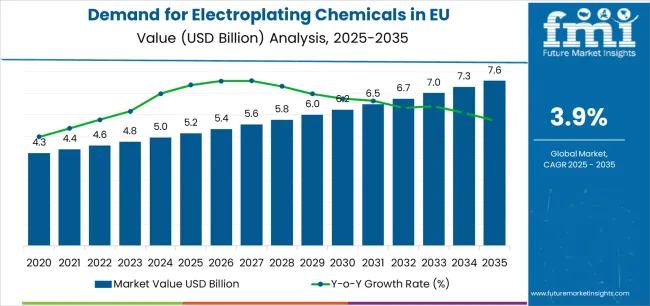
| Metric | Value |
|---|---|
| Estimated Value in (2025E) | USD 5.2 billion |
| Forecast Value in (2035F) | USD 7.6 billion |
| Forecast CAGR (2025 to 2035) | 3.9% |
Between 2025 and 2030, EU electroplating chemicals demand is projected to expand from USD 5.2 billion to USD 6.2 billion, resulting in a value increase of USD 1.08 billion, which represents 45.6% of the total forecast growth for the decade. This phase of development will be shaped by rising demand for automotive electrification requiring advanced copper and nickel plating chemistries, increasing consumer electronics production featuring ultra-miniaturized components, and growing mainstream adoption of eco-compliant trivalent chromium formulations across manufacturing operations replacing legacy hexavalent chromium processes. Manufacturers are expanding their product portfolios to address the evolving preferences for cyanide-free plating baths, high-speed electrodeposition systems, and specialty formulations comparable to premium industrial standards while meeting increasingly stringent European environmental regulations including REACH compliance and RoHS requirements.
From 2030 to 2035, sales are forecast to grow from USD 6.2 billion to USD 7.6 billion, adding another USD 1,290.4 million, which constitutes 54.4% of the overall ten-year expansion. This period is expected to be characterized by further acceleration of eco-compliant chemistry adoption, integration of automated electroplating systems for Industry 4.0 manufacturing environments, and development of innovative formulations targeting specific applications including battery component metallization and advanced semiconductor packaging. The growing emphasis on circular economy principles and increasing manufacturing willingness to invest in sustainable surface finishing technologies will drive demand for advanced electroplating chemicals that deliver exceptional coating performance with minimized environmental impact and enhanced process efficiency characteristics supporting long-term industrial competitiveness.
Between 2020 and 2025, EU electroplating chemicals sales experienced moderate expansion at a CAGR of 3%, growing from USD 4.4 billion to USD 5.1 billion. This period was driven by steady automotive manufacturing activity across European countries, consistent electronics production development, and growing recognition of eco-compliant plating chemistries' regulatory compliance advantages over conventional formulations. The industry developed as chemical suppliers and industrial finishers recognized the commercial potential of advanced plating technologies for corrosion protection, decorative finishing, and functional coating applications. Product quality improvements, enhanced bath stability formulations, and process optimization refinement began establishing strong market acceptance and customer confidence supporting adoption of advanced electroplating chemicals across automotive, electronics, and aerospace manufacturing segments.
EU electroplating chemicals sales are advancing steadily due to increasing automotive electrification across European manufacturing operations and the corresponding demand for high-conductivity, corrosion-resistant, and thermally stable metal coatings with proven effectiveness in battery connector protection, power electronics enhancement, and lightweight component metallization applications. Modern automotive manufacturers and electronics producers rely on electroplating chemicals as essential surface finishing materials for consistent coating performance, precise thickness control, and superior adhesion characteristics, driving demand for products that deliver exceptional corrosion resistance, electrical conductivity, and process reliability compared to alternative surface finishing technologies offering inadequate functional performance and requiring frequent replacement.
The European Union automotive industry represents a particularly significant consumption sector where electroplating chemicals serve critical functions including corrosion protection for structural components, decorative chrome finishing for exterior trim, and functional nickel plating for engine and transmission parts requiring wear resistance and thermal stability. Major automotive manufacturers including Volkswagen Group, BMW, Mercedes-Benz, Stellantis, and Renault systematically utilize electroplating processes throughout vehicle production, implementing advanced plating technologies to achieve stringent quality standards for surface finishing while maintaining operational efficiency and environmental compliance supporting European manufacturing competitiveness. The automotive electrification transition is accelerating electroplating chemical demand as electric vehicle battery systems, power electronics modules, and high-voltage connectors require specialized copper and nickel plating formulations delivering superior electrical conductivity combined with corrosion resistance exceeding conventional automotive requirements.
The growing awareness of environmental sustainability and increasing recognition of eco-compliant electroplating chemistries' regulatory advantages are driving demand for trivalent chromium, cyanide-free gold plating, and alkaline zinc formulations from certified chemical manufacturers with appropriate environmental credentials and performance validation documentation. Regulatory authorities and industry standards organizations are increasingly establishing clear guidelines for hazardous substance elimination, wastewater discharge limits, and worker safety requirements to maintain manufacturing sustainability and ensure process consistency throughout European electroplating operations. Scientific research studies and industrial performance testing are providing evidence supporting eco-compliant chemistries' functional equivalence and environmental benefits, requiring standardized bath management protocols, quality control procedures, and waste treatment specifications for optimal coating quality, appropriate environmental stewardship, and consistent performance across diverse electroplating applications including automotive, electronics, aerospace, and decorative finishing operations.
Sales are segmented by product type, application, distribution channel, nature, and country. By product type, demand is divided into nickel, copper, zinc, chromium, gold, silver, and other plating metals. Based on application, sales are categorized into automotive, electrical and electronics, aerospace and defense, jewelry, machinery parts and components, and others. In terms of distribution channel, demand is segmented into direct B2B sales, distributors, and online marketplace platforms. By nature, sales are classified into eco-compliant and conventional formulations. Regionally, demand is focused on Germany, France, Italy, Spain, the Netherlands, and the Rest of Europe.
.webp)
The nickel plating metal segment is projected to account for 20% of EU electroplating chemicals sales in 2025, declining slightly to 19% by 2035, establishing itself as the dominant plating metal category across European industrial surface finishing and manufacturing applications. This commanding position is fundamentally supported by nickel plating's exceptional corrosion resistance, comprehensive substrate compatibility, and proven performance for industrial applications requiring durable protective coatings with excellent wear resistance and thermal stability. The nickel plating format delivers exceptional functional appeal, providing manufacturers and industrial finishers with a product category that facilitates effective corrosion protection, reliable decorative finishing, and long-term coating integrity essential for automotive components, electronics contacts, and machinery parts. The nickel segment's slight declining share reflects growing adoption of copper plating, which maintains 18% share through 2035, and expanding zinc plating, which grows from 15% to 16%, capturing market share through automotive galvanizing applications and steel corrosion protection installations throughout the forecast period.
Key advantages:
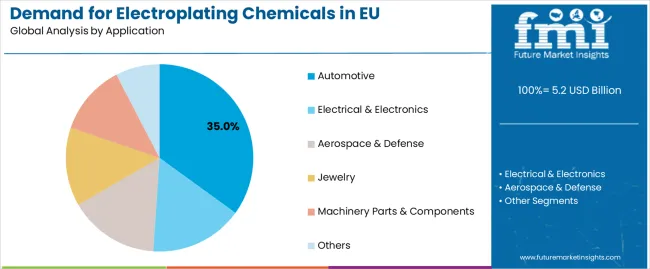
Automotive applications are strategically positioned to represent 35% of total European electroplating chemicals sales in 2025, expanding slightly to 36% by 2035, reflecting the segment's dominance as the primary consumption category within the overall market. This substantial share directly demonstrates that automotive manufacturing represents the dominant application, with electroplating chemicals utilized extensively in body component corrosion protection, decorative trim finishing, and functional coating for powertrain components requiring wear resistance and environmental durability. Modern automotive manufacturers increasingly view electroplating as an essential surface finishing process, driving demand for products optimized for coating uniformity, environmental compliance, and production efficiency that supports vehicle quality enhancement and manufacturing cost optimization. The segment benefits from continuous automotive production activity, expanding electric vehicle manufacturing increasing specialized plating requirements, and manufacturer preference for eco-compliant chemistries delivering regulatory compliance without compromising coating performance.
Success factors:
Direct B2B sales channels are strategically estimated to control 50% of total European electroplating chemicals sales in 2025, declining to 47% by 2035, reflecting the critical importance of supplier-to-manufacturer direct relationships for automotive OEMs, electronics producers, and industrial finishing operations. European direct sales operations consistently demonstrate strong customer retention delivering bulk chemical supply, technical process support, and customized formulation development to industrial customers requiring consistent electroplating chemistry performance. The segment provides essential customer service through dedicated technical assistance, bath management training, and process optimization consultation supporting automotive manufacturing operations and electronics fabrication facilities. The segment's declining share reflects faster growth in online marketplace channels, which expand from 5% to 10%, capturing market share through convenience and small-batch purchasing platforms serving specialty plating operations and laboratory buyers throughout the forecast period.
Growth enablers:
Conventional electroplating chemical products are strategically positioned to contribute 70% of total European sales in 2025, declining dramatically to 45% by 2035, representing products formulated with traditional hexavalent chromium, cyanide-based gold plating, and legacy chemistry platforms without eco-compliant certifications. These conventional products successfully deliver proven coating performance and established process reliability while ensuring broad commercial availability across all distribution channels that prioritize functional effectiveness and operational familiarity over environmental credentials. The segment's dramatic declining share through 2035 reflects the category's rapid evolution toward eco-compliant products, which grow from 30% in 2025 to 55% in 2035, as regulatory-driven manufacturers and environmentally conscious industrial operations increasingly prioritize trivalent chromium formulations, cyanide-free precious metal plating, and alkaline zinc alternatives aligned with REACH compliance, worker safety enhancement, and sustainable manufacturing principles.
Competitive advantages:
EU electroplating chemicals sales are advancing steadily due to increasing automotive electrification in European manufacturing operations, growing electronics production requiring precision metallization, and rising industrial preference for eco-compliant surface finishing chemistries. The industry faces challenges, including capital equipment investment requirements limiting small-scale adoption, environmental compliance costs regarding wastewater treatment and hazardous waste disposal, and technical expertise requirements restricting process optimization capabilities. Continued innovation in cyanide-free formulations and trivalent chromium technologies remains central to industry development throughout the forecast period.
The rapidly accelerating development of eco-compliant and REACH-compatible electroplating formulations is fundamentally transforming industrial surface finishing from traditional hazardous chemistries to environmentally responsible alternatives enabling effective metal deposition with enhanced worker safety, delivering regulatory compliance benefits and environmental stewardship credentials previously unattainable through conventional hexavalent chromium and cyanide-based electroplating products. Advanced chemistry platforms featuring trivalent chromium, cyanide-free gold plating, and alkaline zinc formulations allow manufacturers to create eco-compliant electroplating processes with effective corrosion protection, decorative appearance, and functional performance comparable to conventional chemistries while meeting increasingly stringent European regulations including REACH substance restrictions, RoHS compliance requirements, and wastewater discharge limitations supporting sustainable manufacturing objectives. These sustainability innovations prove particularly transformative for automotive manufacturers, electronics producers, and aerospace contractors where environmental compliance proves essential for market access, regulatory approval, and corporate sustainability commitments supporting responsible industrial operations.
Modern electroplating operations systematically incorporate automated plating lines, real-time bath monitoring systems, and data-driven process control technologies that deliver superior coating uniformity, reduced chemical consumption, and enhanced process consistency comparable to traditional manual plating operations requiring extensive operator expertise. Strategic integration of robotic material handling, inline quality inspection, and predictive maintenance algorithms optimized for electroplating applications enables manufacturers to position automated surface finishing as legitimate industrial solutions where process repeatability directly determines coating quality and production economics among high-volume automotive and electronics manufacturing installations. These automation improvements prove essential for premium market positioning, as automotive manufacturers and electronics producers demand consistent coating thickness, zero-defect quality standards, and process traceability supporting stringent industry specifications and customer satisfaction requirements. Companies implement extensive digitalization programs including bath chemistry sensors, thickness measurement systems, and statistical process control platforms targeting superior production efficiency, including reduced rework rates, optimized chemical utilization, and real-time quality validation throughout electroplating operations and manufacturing environments.
European manufacturers and industrial finishers increasingly prioritize electroplating chemicals as essential process enablers featuring specialized formulations, application-optimized chemistries, and performance-enhanced properties that differentiate advanced manufacturing operations through superior coating functionality and precision deposition control. This specialization trend enables chemical suppliers to drive product differentiation through extensive chemistry portfolios including high-speed nickel sulfamate, ultra-pure gold cyanide-free, and decorative bright chrome alternatives resonating with performance-conscious customers seeking optimized electroplating solutions without compromising coating specifications. Specialized electroplating formulations prove particularly important for aerospace component finishing where corrosion resistance drives material selection and coating standards, with performance validation serving as a critical specification for military aircraft and commercial aviation applications. The development of niche chemistry platforms, substrate-specific pretreatment systems, and post-treatment sealers expands manufacturers' abilities to create customized solutions delivering consistent coating performance with validated adhesion strength, corrosion resistance, and environmental durability.
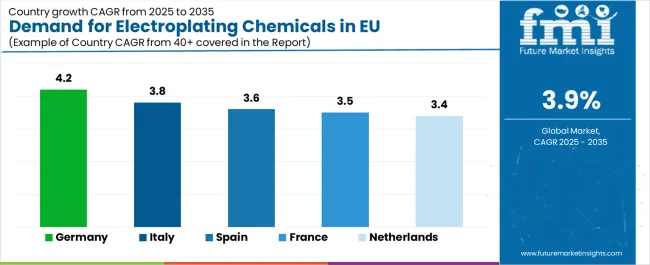
| Country | CAGR 2025-2035 |
|---|---|
| Germany | 4.2% |
| Netherlands | 3.4% |
| Italy | 3.8% |
| Spain | 3.6% |
| France | 3.5% |
EU electroplating chemicals sales demonstrate steady growth across major European economies, with Germany leading expansion at 4.2% CAGR through 2035, driven by automotive manufacturing dominance and electronics production strength. Rest of Europe shows strong growth at 4.1% CAGR through emerging industrial development and manufacturing investment. Italy demonstrates 3.8% CAGR with automotive supplier expansion and machinery finishing activity. Spain records 3.6% CAGR reflecting automotive production growth and aerospace component manufacturing. France demonstrates 3.5% CAGR with consistent automotive operations and electronics fabrication. Netherlands shows 3.5% CAGR with specialized electronics plating and industrial finishing characteristics. Overall, sales show moderate regional development reflecting EU-wide trends toward automotive electrification, electronics production expansion, and eco-compliant chemistry adoption.
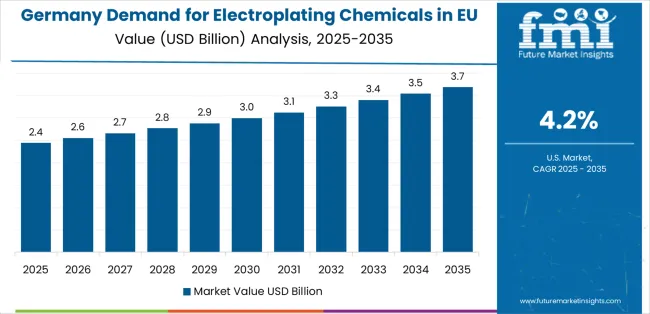
Revenue from electroplating chemicals in Germany is projected to exhibit the strongest growth with a CAGR of 4.2% through 2035, driven by world-leading automotive manufacturing, comprehensive electronics production capabilities, and extensive industrial finishing infrastructure throughout the country. Germany's sophisticated automotive industry and internationally recognized manufacturing quality are creating substantial demand for advanced electroplating chemicals across automotive, electronics, and machinery applications. Major automotive manufacturers including Volkswagen, BMW, Mercedes-Benz, and Audi, combined with extensive tier-one supplier networks throughout German industrial regions, systematically utilize electroplating processes for component finishing, often prioritizing eco-compliant formulations to maintain environmental positioning and regulatory compliance. German demand benefits from stringent coating quality standards requiring validated chemistry performance, substantial automotive electrification investment supporting specialized copper and nickel plating requirements, and technical sophistication that naturally supports advanced electroplating chemical utilization across manufacturing operations.
Growth drivers:
Revenue from electroplating chemicals in France is growing at a robust CAGR of 3.5%, fundamentally driven by established automotive manufacturing, aerospace component production, and quality-focused industrial finishing practices. France's traditionally engineering-conscious industrial culture naturally accommodates advanced electroplating technologies as manufacturers and finishers recognize performance benefits and regulatory compliance advantages. Major automotive manufacturers including Renault and Stellantis, combined with aerospace contractors such as Airbus and Safran, strategically invest in electroplating processes for component finishing and assembly supporting French manufacturing excellence standards. French sales particularly benefit from aerospace precision component finishing creating natural adoption among defense contractors, combined with automotive production in northeastern industrial regions contributing to expansion through integrated supply chain consumption.
Development factors:
Revenue from electroplating chemicals in Italy is expanding at a CAGR of 3.8%, supported by Italy's substantial automotive supplier network, machinery component manufacturing, and established industrial finishing industry practices throughout major Italian industrial regions. Italy's strong manufacturing economy and quality-focused production standards are driving steady demand for reliable electroplating chemicals across automotive, machinery, and decorative finishing applications. Major automotive suppliers and machinery manufacturers maintain comprehensive electroplating operations to serve component finishing requirements and decorative hardware applications across diverse industrial sectors. Italian sales particularly benefit from decorative hardware finishing demanding aesthetic quality and luxury goods plating supporting design excellence supporting premium product positioning, driving product adoption within specialized electroplating chemical categories.
Success factors:
Demand for electroplating chemicals in Spain is projected to grow at a CAGR of 3.6%, substantially supported by automotive manufacturing expansion, industrial component production, and developing electronics assembly throughout Spanish industrial regions. Spanish manufacturing modernization and automotive investment positions electroplating chemicals as essential for production quality strategies supporting international competitiveness. Major automotive manufacturers and tier-one suppliers systematically expand electroplating operations, with automotive component finishing and machinery part metallization proving particularly successful in driving mainstream adoption supporting Spanish industrial development. Spain's growing automotive production volume and manufacturing investment supports electroplating chemical demand among industrial finishers providing surface finishing services to domestic and international manufacturing operations throughout integrated automotive supply chains.
Growth enablers:
Demand for electroplating chemicals in the Netherlands is expanding at a CAGR of 3.5%, fundamentally driven by specialized electronics manufacturing, precision component finishing, and quality-focused industrial operations supporting advanced plating chemistry adoption. Dutch industrial operations demonstrate receptivity to premium electroplating formulations and eco-compliant products meeting stringent environmental standards. Netherlands sales benefit from well-developed electronics sector, specialized industrial finishers facilitating precision plating services, and manufacturing preference for sustainable chemistries driving eco-compliant electroplating adoption across Dutch industrial operations. The country's environmental focus and technical expertise support consistent electroplating chemical demand across electronics, precision engineering, and specialty finishing applications.
Innovation drivers:
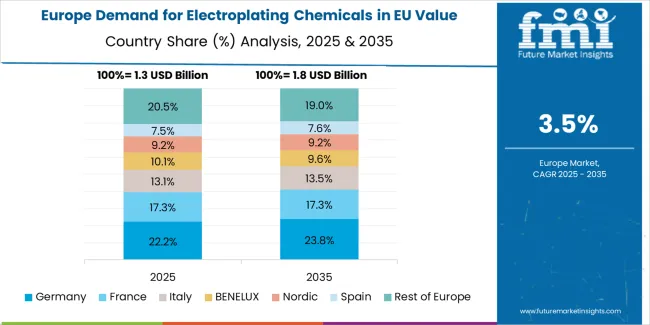
EU electroplating chemicals sales are projected to grow from USD 5,158.4 million in 2025 to USD 7,531.8 million by 2035, registering a CAGR of 3.9% over the forecast period. Germany is expected to demonstrate the strongest growth trajectory with a 4.2% CAGR, supported by advanced automotive manufacturing, extensive electronics production, and comprehensive industrial finishing infrastructure requiring premium electroplating chemistries. Rest of Europe follows with 4.1% CAGR attributed to emerging manufacturing expansion and industrial development. Italy shows 3.8% CAGR, reflecting growing automotive supplier networks and machinery component finishing. Germany maintains the largest share at 38.7% in 2025, driven by manufacturing excellence and quality-focused industrial culture supporting advanced electroplating chemical adoption.
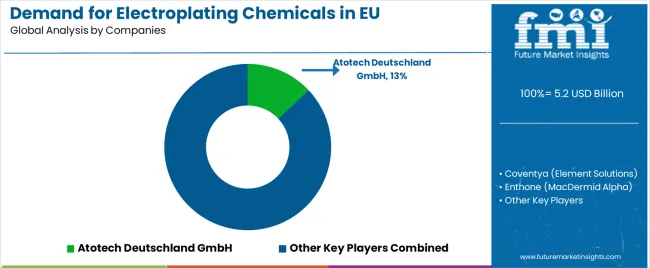
EU electroplating chemicals sales are defined by competition among specialized surface finishing chemical manufacturers, industrial chemical suppliers, and metal finishing solution providers serving diverse automotive, electronics, and industrial applications. Companies are investing in eco-compliant formulation technologies, cyanide-free precious metal plating, trivalent chromium systems, and technical process support to deliver high-quality, performance-validated, and environmentally responsible electroplating chemical solutions meeting stringent European regulatory standards. Strategic partnerships with automotive manufacturers and industrial finisher collaboration initiatives, along with technical support programs emphasizing bath management training and process optimization are central to strengthening competitive position throughout European industrial manufacturing markets.
Major participants include Atotech Deutschland GmbH with an estimated 13% share, leveraging its European electroplating chemistries specialization, comprehensive product portfolio, and established presence through automotive and electronics channels across multiple countries. Atotech benefits from specialized plating chemistry expertise, deep automotive application knowledge, and ability to serve diverse segments from decorative finishing to functional coating installations, supporting manufacturer requirements through technical service excellence and comprehensive electroplating programs. Coventya accounts for approximately 10% share, emphasizing automotive plating solutions, European distribution strength, and product innovation supporting industrial manufacturing positioning. Enthone holds roughly 8% share through its position as pan-European electronics plating leader with strong brand recognition, providing diverse electroplating chemistries through technical expertise and application support. Technic Inc. represents approximately 6% share, supporting growth through precious metal plating focus, specialty formulation portfolio, and European market expansion.
Other companies collectively hold 63% share, reflecting competitive dynamics within European electroplating chemicals sales, where numerous regional chemical manufacturers, international surface finishing suppliers, specialty formulation developers, and emerging eco-compliant chemistry providers serve specific customer requirements, local markets, and niche applications. This competitive environment provides opportunities for differentiation through cyanide-free formulations, trivalent chromium systems, high-speed plating chemistries, and automated process integration resonating with manufacturers and industrial finishers seeking high-quality electroplating chemicals aligned with production requirements and sustainability objectives.
| Item | Value |
|---|---|
| Quantitative Units | USD 7.6 billion |
| Product Type | Nickel, Copper, Zinc, Chromium, Gold, Silver, Others |
| Application | Automotive, Electrical & Electronics, Aerospace & Defense, Jewelry, Machinery Parts & Components, Others |
| Distribution Channel | Direct (B2B), Distributors, Online/Marketplace |
| Nature | Eco-compliant (Cr3+/cyanide-free), Conventional (legacy chemistries) |
| Countries Covered | Germany, France, Italy, Spain, the Netherlands, Rest of Europe |
| Key Companies Profiled | Atotech, Coventya, Enthone, Technic, Specialized electroplating chemical manufacturers |
| Additional Attributes | Dollar sales by plating metal type, application, distribution channel, and formulation nature; regional demand trends across major European manufacturing economies; competitive landscape analysis with established surface finishing chemical manufacturers and industrial plating solution providers; customer preferences for various plating metal chemistries and eco-compliant specifications; integration with automated plating systems and Industry 4.0 manufacturing technologies; innovations in cyanide-free formulations and trivalent chromium chemistry |
Product Type (Plating Metal)
The global demand for electroplating chemicals in EU is estimated to be valued at USD 5.2 billion in 2025.
The market size for the demand for electroplating chemicals in EU is projected to reach USD 7.6 billion by 2035.
The demand for electroplating chemicals in EU is expected to grow at a 3.9% CAGR between 2025 and 2035.
The key product types in demand for electroplating chemicals in EU are nickel, copper, zinc, chromium, gold, silver and others.
In terms of application, automotive segment to command 35.0% share in the demand for electroplating chemicals in EU in 2025.






Our Research Products

The "Full Research Suite" delivers actionable market intel, deep dives on markets or technologies, so clients act faster, cut risk, and unlock growth.

The Leaderboard benchmarks and ranks top vendors, classifying them as Established Leaders, Leading Challengers, or Disruptors & Challengers.

Locates where complements amplify value and substitutes erode it, forecasting net impact by horizon

We deliver granular, decision-grade intel: market sizing, 5-year forecasts, pricing, adoption, usage, revenue, and operational KPIs—plus competitor tracking, regulation, and value chains—across 60 countries broadly.

Spot the shifts before they hit your P&L. We track inflection points, adoption curves, pricing moves, and ecosystem plays to show where demand is heading, why it is changing, and what to do next across high-growth markets and disruptive tech

Real-time reads of user behavior. We track shifting priorities, perceptions of today’s and next-gen services, and provider experience, then pace how fast tech moves from trial to adoption, blending buyer, consumer, and channel inputs with social signals (#WhySwitch, #UX).

Partner with our analyst team to build a custom report designed around your business priorities. From analysing market trends to assessing competitors or crafting bespoke datasets, we tailor insights to your needs.
Supplier Intelligence
Discovery & Profiling
Capacity & Footprint
Performance & Risk
Compliance & Governance
Commercial Readiness
Who Supplies Whom
Scorecards & Shortlists
Playbooks & Docs
Category Intelligence
Definition & Scope
Demand & Use Cases
Cost Drivers
Market Structure
Supply Chain Map
Trade & Policy
Operating Norms
Deliverables
Buyer Intelligence
Account Basics
Spend & Scope
Procurement Model
Vendor Requirements
Terms & Policies
Entry Strategy
Pain Points & Triggers
Outputs
Pricing Analysis
Benchmarks
Trends
Should-Cost
Indexation
Landed Cost
Commercial Terms
Deliverables
Brand Analysis
Positioning & Value Prop
Share & Presence
Customer Evidence
Go-to-Market
Digital & Reputation
Compliance & Trust
KPIs & Gaps
Outputs
Full Research Suite comprises of:
Market outlook & trends analysis
Interviews & case studies
Strategic recommendations
Vendor profiles & capabilities analysis
5-year forecasts
8 regions and 60+ country-level data splits
Market segment data splits
12 months of continuous data updates
DELIVERED AS:
PDF EXCEL ONLINE
Demand for Precious Metal Plating Chemicals in EU Size and Share Forecast Outlook 2025 to 2035
Europe Radiotherapy Patient Positioning Market Size and Share Forecast Outlook 2025 to 2035
Europe Polyvinyl Alcohol Industry Analysis Size and Share Forecast Outlook 2025 to 2035
Europe Cruise Market Forecast and Outlook 2025 to 2035
Europium Market Forecast and Outlook 2025 to 2035
Electroplating Market Size and Share Forecast Outlook 2025 to 2035
Eucommia Leaf Extract Market Size and Share Forecast Outlook 2025 to 2035
Europe Massage Therapy Service Market Size and Share Forecast Outlook 2025 to 2035
Europe Cement Market Analysis Size and Share Forecast Outlook 2025 to 2035
European Union Tourism Industry Size and Share Forecast Outlook 2025 to 2035
Europe Injection Molding Machines Market Size and Share Forecast Outlook 2025 to 2035
Europe Injection Moulders Market Size and Share Forecast Outlook 2025 to 2035
Europe and MENA Generic Oncology Drug Market Size and Share Forecast Outlook 2025 to 2035
Europe Masking Tapes Market Size and Share Forecast Outlook 2025 to 2035
Europe Liners Market Size and Share Forecast Outlook 2025 to 2035
Europe Dermal Fillers Market Size and Share Forecast Outlook 2025 to 2035
Europe Trolley Bus Market Size and Share Forecast Outlook 2025 to 2035
EU Battery Passport Solutions Market Analysis - Size, Share, and Forecast Outlook 2025 to 2035
Europe Protease Market Size and Share Forecast Outlook 2025 to 2035
Europe Luxury Packaging Market Size and Share Forecast Outlook 2025 to 2035

Thank you!
You will receive an email from our Business Development Manager. Please be sure to check your SPAM/JUNK folder too.
Chat With
MaRIA